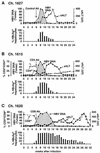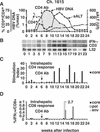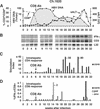CD8(+) T cells mediate viral clearance and disease pathogenesis during acute hepatitis B virus infection
- PMID: 12477811
- PMCID: PMC140637
- DOI: 10.1128/jvi.77.1.68-76.2003
CD8(+) T cells mediate viral clearance and disease pathogenesis during acute hepatitis B virus infection
Abstract
Although the CD4(+)- and CD8(+)-T-cell responses to the hepatitis B virus (HBV) are thought to be crucial for the control of HBV infection, the relative contribution of each T-cell subset as an effector of viral clearance is not known. To examine this question, we monitored the course of HBV infection in control, CD4-depleted, and CD8-depleted chimpanzees. Our results demonstrate that CD8(+) cells are the main effector cells responsible for viral clearance and disease pathogenesis during acute HBV infection, and they suggest that viral clearance is mediated by both noncytolytic and cytolytic effector functions of the CD8(+)-T-cell response.
Figures




References
-
- Bertoletti, A., M. M. D'Elios, C. Boni, M. De Carli, A. L. Zignego, M. Durazzo, G. Missale, A. Penna, F. Fiaccadori, G. Del Prete, and C. Ferrari. 1997. Different cytokine profiles of intrahepatic T cells in chronic hepatitis B and hepatitis C virus infections. Gastroenterology 112:193-199. - PubMed
-
- Bertoletti, A., C. Ferrari, F. Fiaccadori, A. Penna, R. Margolskee, H. J. Schlicht, P. Fowler, S. Guilhot, and F. V. Chisari. 1991. HLA class I-restricted human cytotoxic T cells recognize endogenously synthesized hepatitis B virus nucleocapsid antigen. Proc. Natl. Acad. Sci. USA 88:10445-10449. - PMC - PubMed
-
- Bertoni, R., A. Sette, J. Sidney, L. G. Guidotti, M. Shapiro, R. Purcell, and F. V. Chisari. 1998. Human class I supertypes and CTL repertoires extend to chimpanzees. J. Immunol. 161:4447-4455. - PubMed
Publication types
MeSH terms
Substances
Grants and funding
LinkOut - more resources
Full Text Sources
Other Literature Sources
Medical
Research Materials

